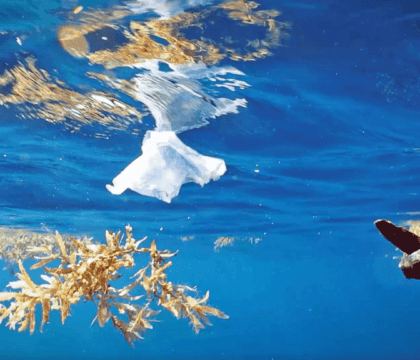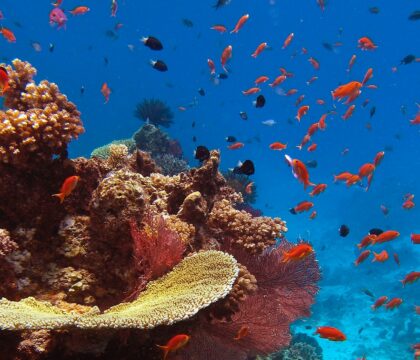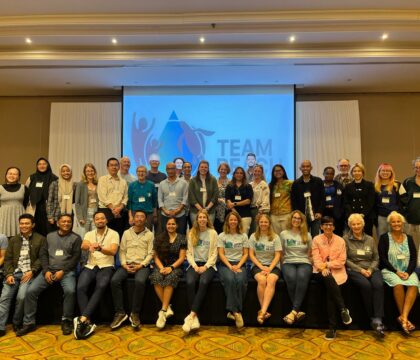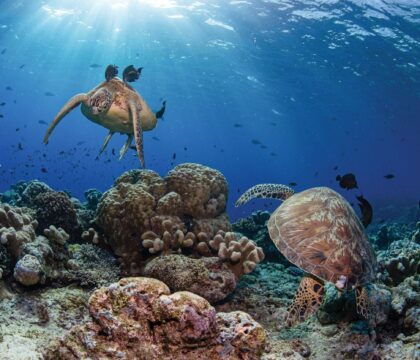November 1, 2022 • Travel Ideas
Located at the heart of the Coral Triangle region, Raja Ampat, Indonesia is home to some of the highest marine biodiversity in the world. It is also home to some of the world’s best snorkeling and scuba diving, which is best enjoyed via liveaboard trips that generally range from one to two weeks in length.

The breathtaking landscape of Raja Ampat’s “Secret Bay.” © Wayne Sentman
About Raja Ampat, Indonesia
Raja Ampat is a remote archipelago in eastern Indonesia that consists of more than 2,500 small islands and reefs off of the northwestern tip of the island of New Guinea. There are four large, mountainous islands in Raja Ampat—Batanta, Misool, Salawati, and Waigeo—for which the archipelago is named; Raja Ampat means “Four Kings” in Bahasa Indonesia (raja = king, and ampat [or empat] = four). The archipelago encompasses approximately 43,000 square kilometers of land and sea, and is sparsely populated, with most islands being uninhabited.
Raja Ampat (as well as the nearby Savu and Banda Seas) is home to some of the world’s highest marine biodiversity, a fact that was only discovered by scientists within the past 20 years. Since then, Raja Ampat has become the focus of extensive research and conservation efforts by international and local organizations, and a hotspot for snorkel and dive tourism. Today, much of Raja Ampat is protected as part of the Raja Ampat Marine Protected Area network of seven protected areas that cover 1,185,940 hectares (2,930,522 acres).

Coral reefs in Raja Ampat are not only the world’s most biodiverse, but they are also some of the most pristine. © Pete Oxford
New species are still being discovered regularly in Raja Ampat, adding to the already impressive totals—more than 1,400 fish species and 550+ species of reef building corals (75% of the world’s coral species) are found here, as well as 17 species of marine mammals, 25 species of mangrove, and other iconic species such as whale sharks, sea turtles, walking sharks, and manta rays.
The islands—many of which are made of rugged, sharp limestone karst —are also home to a number of indigenous and traditional human communities, as well as lush forests, rare plants, and endemic birds (including Wilson’s and Red Birds of Paradise).
Enjoying the view aboard a liveaboard ship in Raja Ampat, Indonesia. © Pete Oxford
Raja Ampat Liveaboard Snorkeling Trips
Raja Ampat is home to some of the world’s best snorkeling, with an abundance of pristine, shallow reefs, diverse habitats, good visibility, and warm water temperatures. The best way to snorkel or scuba dive in Raja Ampat is aboard a liveaboard cruise, which will allow you to visit a variety of habitats, to maximize your time in the water and minimize time in transit, and to be flexible to local weather conditions and other factors when choosing daily snorkel or dive sites.
The best way to snorkel or scuba dive in Raja Ampat is aboard a liveaboard cruise, which will allow you to visit a variety of habitats, to maximize your time in the water and minimize time in transit, and to be flexible to local weather conditions and other factors when choosing daily snorkel or dive sites.
We have four liveaboard expeditions in Raja Ampat scheduled across multiple departure dates:
- Raja Ampat Archipelago by Liveaboard: This is our classic Raja Ampat snorkeling trip that was named one of National Geographic Traveler’s “50 Tours of a Lifetime” in 2010. Our itinerary hits the highlights of Raja Ampat with a focus on experiencing the best snorkeling available. We will also venture on land to explore the forests of Waigeo and Gam Islands and to search for endemic birds of paradise.
- Raja Ampat: Coral Triangle Adventure: Experience luxurious accommodations and top-notch service aboard a luxury liveaboard ship as we enjoy in-depth snorkeling or scuba diving amid the many outstanding marine habitats of Raja Ampat. Our on-board cetacean expert from Planet Deep has more than 20 years experience in the Coral Triangle and will help spot and identify marine mammals along the way. When possible we may also have the chance to get in the water to snorkel alongside whales and dolphins.
- Raja Ampat: Small Group Snorkeling Adventure: A notch up from our classic Raja Ampat expeditions, on this trip you will enjoy a smaller group size and higher class of service aboard the Damai II liveaboard, including complimentary sunset massages, as we immerse ourselves in the underwater world of Raja Ampat. We’ll explore shallow reefs with abundant fish, blue water mangroves rich with soft corals and macro life, and known habitats for iconic Coral Triangle species ranging from colorful mantis shrimp to breathtaking manta rays and otherworldly tasseled wobbegong sharks.
- Indonesia Megadiversity Expedition: Experience this exceptional “off-the-grid” itinerary that was custom designed by marine conservation partner Planet Deep. Our trip takes place aboard the boutique Fenides, a luxury liveaboard ship with just 5 cabins and world-class service. This trip was given the title of “megadiversity expedition” because it offers a chance to explore Indonesia’s remarkable biodiversity in many ways. We’ll look for blue whales in the Lease Islands Marine Protected Area and soft coral gardens and sea fans, plus carnivorous pitcher plants and orchids in Misool; we’ll enjoy swimming with manta rays and looking for hornbills and parrots in Batanta; and we’ll explore the fish rich waters around Kri.
In addition, we are leading more and more special liveaboard expeditions to nearby areas of the Coral Triangle that contain equally high marine species diversity and offer comparable snorkeling, diving, and wildlife viewing to Raja Ampat. Current offerings include:
- Banda Sea: Reefs, Blue Whales, and Hammerhead Sharks: Explore the beautiful coral reefs surrounding the volcanic islands of Ambon on this Banda Sea liveaboard expedition. Located at the border where the Pacific and Indian Oceans collide, this area harbors some of those most biodiverse coral reef ecosystems in the world and is a hotspot for blue whales. Our expedition takes place aboard a luxury liveaboard and brings together professional conservationists and passionate guests for a unique and enriching experience. Selecting ideal snorkeling and dive sites daily, we will immerse ourselves in diverse marine habitats and sail among the many uninhabited jungle-capped islands, complemented by dedicated time to look for whales.
- Indonesia: Halmahera to Sulawesi: Join us as we travel this unique and rarely offered itinerary in the biogeographic region of Wallacea, beginning at the “Spice Island” of Halmahera and making our way to Sulawesi. Halmahera has some of the best hard coral gardens in Indonesia and is still being explored. In Sulawesi we will encounter unique macro critters and visit the Tangkoko Nature Reserve, a haven for endemic species. Weather permitting, we will also stop at the Togean Islands and visit the Red Jellyfish Lake. Don’t miss your chance to be among the first travelers to explore this special region.

Diverse, shallow reefs like this lead to some of the world’s best snorkeling in Raja Ampat. © Pete Oxford




